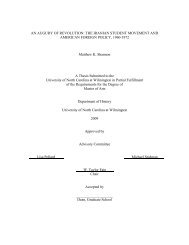HIERARCHAL INDUCTIVE PROCESS MODELING AND ANALYSIS ...
HIERARCHAL INDUCTIVE PROCESS MODELING AND ANALYSIS ...
HIERARCHAL INDUCTIVE PROCESS MODELING AND ANALYSIS ...
You also want an ePaper? Increase the reach of your titles
YUMPU automatically turns print PDFs into web optimized ePapers that Google loves.
e a subset of the set of good fit models selected with two of the three time-series<br />
previously mentioned. This puts an important emphasis on which measurements<br />
and observations added to the search. The decision of adding an extra time-series to<br />
the software should be highly influenced by which data has already been collected<br />
and used with HIPM. That being said this could be an area where HIPM could be<br />
enhanced and a direction for further research. Indeed, it would be interesting to look<br />
at the output of HIPM if the reMSE was calculated by taking the maximum square<br />
error of all the variables being fitted which would then make our assumption, that<br />
more time-series data equates fewer models, valid.<br />
The parameter selection process<br />
is a very important step of HIPM model selection; this statement was reinforced<br />
by the mathematical analysis that made evident the sensitivity of the system to parameter<br />
values. Differences in parameter values could mean the difference between a<br />
population going to extinction or not. In the case of nitrate and iron I observed that<br />
specific parameters acted as bounds for these variables, which is useful information.<br />
Indeed, when looking at a model through mathematical analysis one can determine<br />
if a parameter will have a significant effect on the overall dynamics of the system.<br />
Coupling this information with experts knowledge it would then be possible to redefine<br />
the ranges set within HIPM for the parameter selection, which would in turn<br />
refine the search process. Scientists could then run the software once again, take<br />
the result and see if parameters ranges could be further refined. This can almost be<br />
seen as a cycle, deriving information on the parameters from the analytical analysis<br />
which in turn help better the constraints given to HIPM, then repeating the process<br />
to see the improvement made to the type of model being selected. This in itself can<br />
be seen as a procedure that transcend just the phytoplankton dynamic in the Ross<br />
Sea ecosystem and can be generalized to other systems.<br />
Automated modeling is a successful method, the LAGRAMGE framework has<br />
been successfully applied in a real-world domain and selected models that performed<br />
67
















